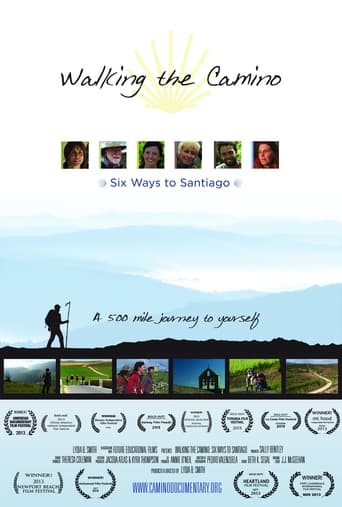



Not even bad in a good way
Did you people see the same film I saw?
The movie really just wants to entertain people.
There's no way I can possibly love it entirely but I just think its ridiculously bad, but enjoyable at the same time.
View MoreMy wife and I have driven the Camino back in '93 but I could not walk it so this comment may be skewered a great deal; however, we did start it in Paris and drove as close to the real Camino as we could. I honestly did not want to give it a low vote because both Diane and I expected more from the film. I have often criticised reviewers for saying what I just said,"...expected..." because a viewer does not have the right to believe that a film should follow their cinematic desires. We did not think that the script picked the right people to follow on their journey. We also believed that the ones they did follow were cut off too quickly; those stories were the most interesting and we never heard of what happened to the people again. The camera work was very good, however, and the scenes photographed for the film were superb. However, because it was a documentary we believed that there could be more pedantic information about prices, foods eaten and places taken for sleep if the Camino establishments were full. A film for the thoughtful though.
View MoreGreetings again from the darkness. There aren't many traditions that span more than 1200 years, and only one of those involves walking 500 miles the Camino de Santiago. Its origin is as a religious trek to Santiago de Compostela where tradition holds that the magnificent cathedral contains the remains of St. James the Apostle. These days, the Camino is no longer limited to those with Christian beliefs, and in fact many modern day pilgrims take it on as a personal quest rather than a spiritual journey.Director Lydia B Smith and her camera allow us to travel along with a group of (six) pilgrims, each with their own story, background and motivation. The journey involves both physical and emotional challenges, and results in varying degrees of self-awareness. One obvious difference in today's pilgrims versus those of medieval times is the experience is much more communal these days. Not only do the walkers eat and sleep in the same hostels along the route, they also freely share their emotions and thoughts with each other (and the camera). This contrasts greatly with the tradition of solitude and quiet introspection. Call it a lesson in generational differences.The elements rotate between favorable and challenging. The pilgrims must face cold, hot, rain, and wind. These obstacles of nature are magnified with foot blisters, sore knees and other bodily ailments. However, for most of these people, the mental challenge is every bit as steep. For 6 plus hours each day over approximately 35 days, they focus on the incredible scenery as well as their own thoughts. It's impossible to hide from one's self, even though friendship and even relationships form along the path.Each of those who complete the journey realizes it's not about the destination, but rather the inspiration and spiritual enlightenment – even if it wasn't their original goal. There is talk about the "internal Camino" and how you walk with your heart. Reflection on this spectacular path leads to harmony with nature and self. A lovely Spanish guitar accompanies our viewing pleasure, and it's impossible not to imagine ourselves on this journey. If inspiration strikes, just be aware that spending that much time with one's self is an activity far removed from our generation's typical day.
View MoreNowadays we are constantly bombarded by disaster, horror and destruction on a daily basis. When I left the theatre after viewing "Walking the Camino" I was totally relaxed and felt that there was a greater purpose to life. As often happens to me, I had just finished reading a book by Paulo Coelho called "The Pilgrimage" where he describes his experiences on the trek to Santiago de Compostela. He had some pretty momentous stories to tell, so naturally I was extremely interested to find out that others have been doing this walk and also that a movie had been made about it.What makes the movie work for me was that we follow the trek of various couples and individuals from all sorts of different ages, countries of origin and occupations. Without exception, they all seem to experience trans-formative events along their journey and are far more in tune with themselves and the world at the end of the journey. The excessive walking and exercise seems to clean out their system from physical and emotional junk and allows them to appreciate the world that exists right in front of them on a NOW basis. Filming the end of the walk must have been really tough for the film maker, because all the subjects were so emotional about what they had been through and experienced.
View MoreThis film is AWESOME in so many ways. For those that have walked the Camino, this is a fantastic film for reminiscing and inspiring a second Camino. For those that are considering the Camino for an adventure of a lifetime, this is an absolute rendition of what walking the Camino is like. Yet, each person experiences their own camino; Prospective Camino walkers will experience their own Camino too! And for everyone, those that walked, those that aspire to walk, and those merely curious, the film touches every range of emotion, fear, tear, excitement, and laughter, and captures the spirit of walking the Camino! More info about the Camino (and the various routes for walking) is available at americanpilgrims.com or APOC. Buen Camino
View More